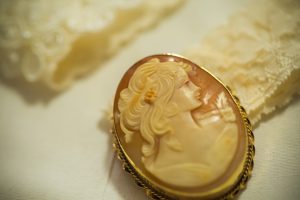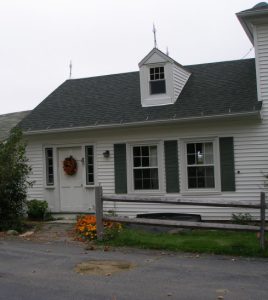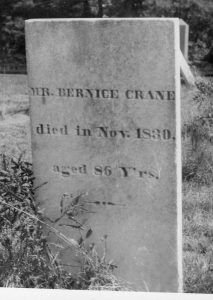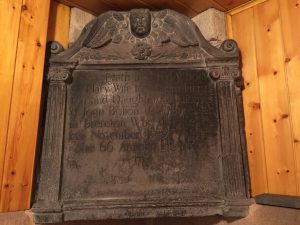 Several decades ago, my father was planting bulbs in our backyard flower garden. An old stone wall borders the garden and our yard, as well as all the neighbors’ yards on my street. Digging into the soil, my father found more than the usual collection of rocks and earthworms – he disinterred a pair of nineteenth-century lady’s boots. Continue reading ‘Their furrows plough’
Several decades ago, my father was planting bulbs in our backyard flower garden. An old stone wall borders the garden and our yard, as well as all the neighbors’ yards on my street. Digging into the soil, my father found more than the usual collection of rocks and earthworms – he disinterred a pair of nineteenth-century lady’s boots. Continue reading ‘Their furrows plough’
Tag Archives: Object Lessons
‘Something old, something new’
 I’ve been a bridesmaid in four weddings. In each of these weddings, the bride has carefully chosen four special items to wear on her wedding day: something old, something new, something borrowed, and something blue. And when preparing for the first three weddings, I didn’t think much of the custom. But when my sister-in-law got married in April, and showed me her something old, new, borrowed, and blue, I couldn’t help but think: why on earth are women doing this? ‘Something old, new, borrowed, blue’? Did my mother do it? My grandmother? My great-grandmother? Continue reading ‘Something old, something new’
I’ve been a bridesmaid in four weddings. In each of these weddings, the bride has carefully chosen four special items to wear on her wedding day: something old, something new, something borrowed, and something blue. And when preparing for the first three weddings, I didn’t think much of the custom. But when my sister-in-law got married in April, and showed me her something old, new, borrowed, and blue, I couldn’t help but think: why on earth are women doing this? ‘Something old, new, borrowed, blue’? Did my mother do it? My grandmother? My great-grandmother? Continue reading ‘Something old, something new’
The Parkman House

Among the many treasures in the Society’s collection is an extraordinarily well-preserved circa 1847 oil painting by Philip Harry of a grand Boston home that no longer exists: the late eighteenth-century Samuel Parkman House on Bowdoin Square in the West End.
Founded in 1788, Bowdoin Square had, by the early nineteenth century, become one of the most prestigious residential areas of the city and home to many of Boston’s leading families, including the Parkmans. (Samuel Parkman, who built the house around 1789, was a successful merchant who made a fortune in real estate as Boston grew into one of the most important cities in the new republic.) Continue reading The Parkman House
Well be gone

Researching family history takes us to many places: libraries, museums, various genealogical repositories (New England Historic Genealogical Society, of course!), cemeteries, and . . . driveways. An historical archaeological adventure is the sort of research that happened when I wasn’t looking!
The dooryard and then the driveway of my old Asa Williams house had always been hard-packed dirt, until in 1979 my father had the chance to have it paved, making it easier to plow in winter and eliminating the usual signs of mud season. If asphalt improved the look of things, it also covered a multitude of landscaping sins. Continue reading Well be gone
ICYMI: The Name Game
[Editor’s note: This blog post originally appeared in Vita Brevis on 4 February 2015.]
Bonus note: Vita Brevis blogger Penny Stratton is retiring from NEHGS today after ten years on the Publications team. In honor of her departure, I asked her to pick a post to run again. The finalists involved one about apostrophes; one about changes in technology during her career; one about her late father; and the one here—about family names. Penny will continue to do occasional work for NEHGS and promises to contribute more posts to Vita Brevis, and to continue to correct grammar and punctuation in whatever publication she is handed.

When my daughter was born, we chose the name Emma for her. Like many first-time parents, we considered and discarded many names. But we kept circling back to Emma because it’s a family name, and it follows an interesting pattern:
Emma Powell, born 1836 in Bristol, England
Ella Byrt, born 1860 in Chicopee, Massachusetts
Emma Ladd, born 1886 in New York
Ella Clark, born 1915 in Richmond Hill, New York Continue reading ICYMI: The Name Game
Another day at the beach
 I am fortunate in having photographs of many of my relatives, and more fortunate still in that I can identify so many of them. Often the work has been done for me, as to names; sometimes my work is cut out for me in terms of fitting them into the family tree. I have photos of all four of my grandparents as children, in the early years of the twentieth century, so I’m also lucky that my great-grandparents (or other relatives) took the trouble to take them to a professional photographer to be recorded.
I am fortunate in having photographs of many of my relatives, and more fortunate still in that I can identify so many of them. Often the work has been done for me, as to names; sometimes my work is cut out for me in terms of fitting them into the family tree. I have photos of all four of my grandparents as children, in the early years of the twentieth century, so I’m also lucky that my great-grandparents (or other relatives) took the trouble to take them to a professional photographer to be recorded.
My paternal grandfather, Gilbert Livingston Steward (1898–1991), was photographed by Scheur of New York – I think! It is one of the photos in my paternal grandmother’s album, and I like to think it was a present from my great-grandmother[1] at the time of my grandparents’ engagement in 1927. The photo shows GLS at about the time he went off to St. George’s School in Rhode Island. Continue reading Another day at the beach
Memorials
 Memorial Day comes with many family duties. In our family, although I am now the only one who lives in the state where the bulk of our family members are buried, the duty falls on my brother and his wife, who come up from Florida for the summer and stay with her family. (They live closer to the cemeteries.) John and Jan visit each grave, prune rhododendron bushes planted by my grandmother 70 years ago, clear off gravestones, and plant flowers. They then e-mail digital photos to the family. Continue reading Memorials
Memorial Day comes with many family duties. In our family, although I am now the only one who lives in the state where the bulk of our family members are buried, the duty falls on my brother and his wife, who come up from Florida for the summer and stay with her family. (They live closer to the cemeteries.) John and Jan visit each grave, prune rhododendron bushes planted by my grandmother 70 years ago, clear off gravestones, and plant flowers. They then e-mail digital photos to the family. Continue reading Memorials
At the margin

One of the joys of old photographs is the occasional detail, the one that hovers at the margin, away from the central feature of the image. Looking through one of my grandmother’s albums – helpfully marked “Vol. 1,” although I’m not sure there are any subsequent ones in the series – I’m struck by the horses and cars (even the occasional ostrich) that coexist with the people peopling the photographs. My grandmother’s family was considered very “horsey,” and they were happy to be associated with their powerful cars – and I think there is a bit of a story to be found in these images. Continue reading At the margin
The House Beautiful

The New England Historic Genealogical Society is rediscovering many treasures within its Atkinson-Lancaster Collection, an eclectic assemblage of art that came to the Society in 1933 from the Atkinson family of Newburyport, Massachusetts. The Atkinsons made their fortune in the nineteenth-century India trade. We’ve just rehung the Treat Rotunda (Figure 1) with pieces from the collection, including two lovely celadon-and-cream-colored nineteenth-century Chinese garden seats (Figure 2, below). Continue reading The House Beautiful
A final resting place
 In the virtual world of genealogy, one can easily go to www.findagrave.com or www.billiongraves.com and record a gravestone – or simply pay respects to an ancestor’s gravestone. This technology has made it possible for countless genealogists to virtually visit or search gravestones thousands of miles away. This technology can also be utilized by apps designed for your smartphone.
In the virtual world of genealogy, one can easily go to www.findagrave.com or www.billiongraves.com and record a gravestone – or simply pay respects to an ancestor’s gravestone. This technology has made it possible for countless genealogists to virtually visit or search gravestones thousands of miles away. This technology can also be utilized by apps designed for your smartphone.
What about the gravestone no longer located in its original cemetery? When I first started working on my book A Guide to Massachusetts Cemeteries in 1987, I made inquiries into cemeteries throughout the Commonwealth of Massachusetts. Strange stories of abandoned gravestones located on stone walls or at historical societies became a database in their own right. Continue reading A final resting place